Plumbing pipes for sewage: types and features of
What materials are modern sewer pipes made from? Do their installation have any features that a potential owner should know? What solutions are preferred for an apartment or a private house? Let's figure it out.

Scroll
First, let's list all the solutions on the market.
- Cast iron - time-tested classic. Gray cast iron favorably differs from steel by corrosion resistance, which, in fact, has earned popularity during times of cheap metallurgical products and a shortage of plastics. Now he was forced to make room for the omnipresent polymers.
- Polyvinyl chloride - the current leader in sales. Its main advantage is the minimum price with more than tolerable performance and exceptional durability.
- Polypropylene is a bit more expensive and less common.. Its main advantage against the background of the previous material is high temperature resistance: if PVC plumbing pipes for sewage systems are limited to a long-term working temperature of 65 ° C, then polypropylene pipes also serve excellently at 90 C.
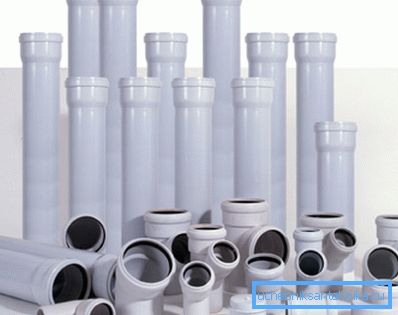
In addition: polypropylene is the lightest (0.91 g / cm3) and one of the most hard plastics. It is practically not subject to wear, even when transporting waste with a large amount of abrasive.
- Polyethylene is rather poorly demanded because of its very low heat resistance: the sewage system made of polyethylene pipes is designed for a temperature of drains not higher than 40 ° C. However, the pressure pipes made of it are fully compatible with PVC with the appropriate diameter (50, 110 and 150 mm) and can be used very successfully as risers: thick walls and elasticity make the movement of drains in an apartment building virtually inaudible.
Dimensions
What sections and slopes should adhere to when designing a drainage system?
| Diameter of pipe, mm | Application |
| 50 | Connecting one or two plumbing fixtures, except for the toilet bowl (showers, bathtubs, washbasins, sinks, etc.) |
| 110 | Connecting the toilet; connection of three or more other types of devices simultaneously used; riser in a block of flats |
| 150 | Connecting two or more toilets with the possibility of simultaneous use; release to a well in an apartment building |
| 200 - 300 | Areas between wells |
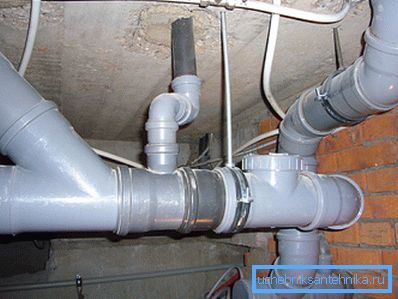
What should be the slope of the pipe?
| Diameter of pipe, mm | Slope, cm / linear meter |
| 50 | 3.5 |
| 110 | 2 |
| 150 | one |
| 200 | 0.8 |
Now let's take a closer look at the properties and installation of various types of sewage.
Cast iron
Special features
Its main advantage is its excellent acoustic properties. Drain in the toilet of neighbors on top will not disturb your sleep, if the sewer riser is made of cast iron: the thickness and weight of the walls will allow the pipe to completely absorb the sound.
Alas, all other properties of cast iron can be safely attributed to the disadvantages.
- The retail cost of pipes and fittings is several times higher than that of any type of polymer.
- Mass makes loading, transporting and assembling extremely uncomfortable. If plumbing plastic sewer pipes and hardware used as fasteners are easily and easily mounted by one person, then replacing the cast-iron riser will require the participation of at least two people with good physical development.
- Cutting the pipe in place or cutting it when dismantling near the wall is not a trivial task. It will take a grinder with a circle on the metal; and to cut the pipe with a section of 110 mm from the side of the wall it will be problematic, to put it mildly.
Useful: plumbers with experience make a notch on a cast-iron pipe with a chisel, and then break it along the line of a notch. However, without proper practice, you are likely to simply spoil the expensive material.
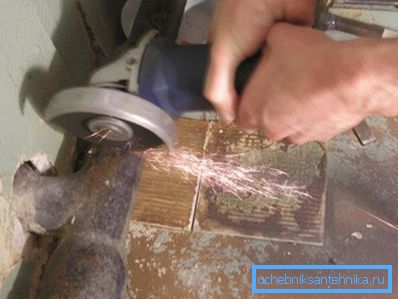
- Mounting the joint requires stamping and subsequent embedding in cement mortar. Each joint takes at least fifteen minutes from an experienced plumber installer.
On the installation we will focus a little more.
Installation
How is a cast iron socket sewer connection sealed?
- The pipe is inserted into the socket and fixed with clamps or hangers. Temporary fixation of the riser is performed by installers simply and uncomplicated: the pipe is suspended above the socket on a pair of bent welding electrodes.
- Then the socket is completely filled with a sealing material with layer-by-layer compaction using a special tool - embossing - or a conventional wide screwdriver. Regularly as a sealant a cabol is used - tow soaked with bitumen mastic; However, the best results are obtained with the use of embossing graphite gland - asbestos fiber with powdered graphite.
- The last stage is the embedding of the socket over the seal with a cement-sand mortar in a ratio of 1: 1.
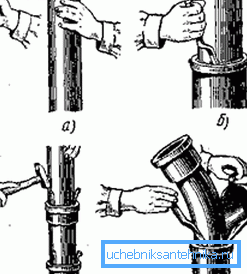
How to dismantle the old cast iron sewer?
- A cement putty is carefully broken by a screwdriver or chisel and a light hammer in a circle.
- The same tools partially removed the cabol.
- After the part of the fitting has been removed, the pipe can be removed from the socket by turning it several times. The process can be accelerated by heating the socket with a blowtorch, a gas torch or a building dryer.
Useful: in homes of about half a century, molten sulfur was often used as a sealant. The simplest way to disassemble such a compound with your own hands is to warm it up to the melting point of sulfur. The main instruction for this job is to remember to put on a gas mask: evaporation is so corrosive that it can easily cause respiratory paralysis.
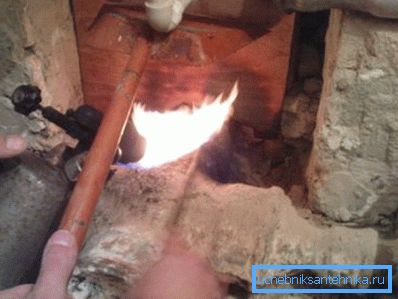
Plastics
Many properties and, most importantly, the methods of installation of plastic sewage systems are common to all polymers used, so we will combine them in one subsection.
Special features
Where is it reasonable to apply each of the plastics?
What are some of their features useful to know?
- Polyvinyl chloride is a versatile, low-cost solution, perfectly suited for domestic wastewater. Pipes for domestic sewage gray; the outer tubes and the fasonine with greater ring stiffness are made orange. Plastic is afraid of strong blows (especially at low temperatures) and perfectly conducts sound.
- Polypropylene is used where heat is high. There are no other significant advantages on the PVC background. However, the cost of materials varies slightly.
- Polyethylene acoustic characteristics approaching cast iron. Since the predominantly commercially available polyethylene pressure pipes do not have sockets, they are mounted with PVC or polypropylene fittings.
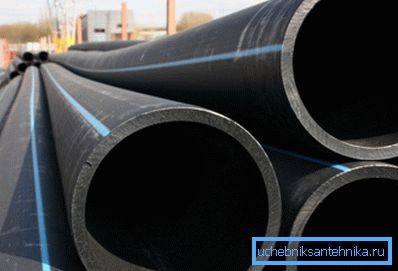
It is useful to know more about a couple of types of sewer pipes.
- The so-called silent sewage system is a three-layer structure, the middle layer of which has an increased density due to saturation with mineral additives. The noise level is indeed noticeably reduced, although the acoustic characteristics of such a solution do not reach the iron.
- Double-layer corrugated pipes (Korsis, Pragma, etc.) are used in the construction of collectors of medium and large diameters (up to 2400 mm). The pipe is a sandwich of corrugated polypropylene on the outside and smooth polyethylene inside. The first provides a high ring stiffness, the second - the minimum hydraulic resistance.
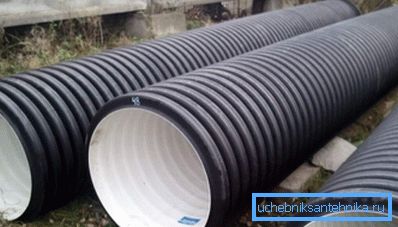
Installation
Thanks to rubber sealing rings it is extremely simplified.
A few little tricks, however, are worth mentioning.
- The maximum distance between the fixing points of a horizontal pipe is 10 diameters. Increasing this distance will lead to the fact that in a year or two the site will sag, and the resulting counter-slope will cause permanent blockages.
- On a pipe cut to size it is worth removing the outer chamfer. Then she will enter the socket much easier.
- Before assembling the ring seal, it makes sense to moisten it with liquid soap or just rub it with a bar of a usual toilet. This will greatly reduce the force required to join.
- When installing the sewer system hidden behind false walls, it is better to assemble it with silicone sealant. With long interruptions in use, rubber rings can crack, lose elasticity and leak. Silicone will prevent this process.

Conclusion
Of course, to tell all about sewage pipes in a small article is quite problematic; we limited ourselves to a small overview of frequently used solutions. The video in this article will offer the reader some amount of additional information. Successes!